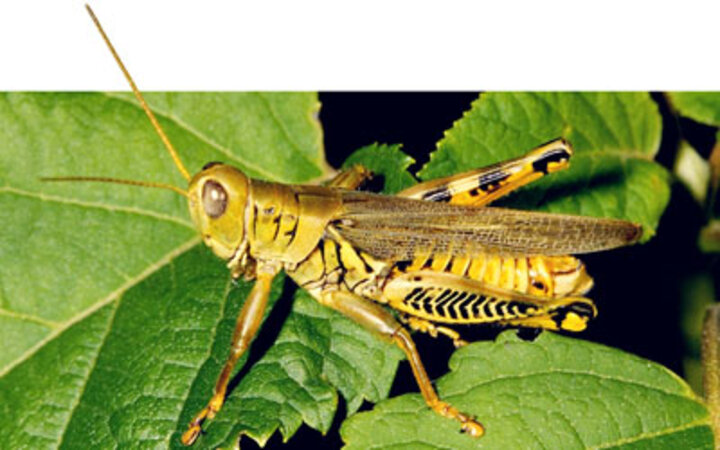
August 22, 2014
Grasshopper populations have been down across the state this year. This has been true for our early, rangeland species as well as our later-season species that tend to invade crops. However, hotspots remain and management actions should be considered for the next wheat crop in areas that have experienced consistently high densities of grasshoppers.
Large grasshopper outbreaks generally go in cycles. After a couple years of high grasshopper numbers, the beneficial organisms that keep these populations in check have mostly regained their hold. However, especially considering the drought and the value of our grain, it is still very important to scout and manage for grasshoppers accordingly in winter wheat. In locations where grasshoppers remain abundant, they might be surrounding this year's wheat planting beds and may threaten seedlings as they emerge. Emerging winter wheat has very limited foliage; therefore, large grasshopper numbers could easily keep the wheat clipped back completely, causing stand losses, particularly at field margins.
Grasshopper populations decline through the late summer and fall, but they can remain in significant densities until after the first hard freeze. Growers need to monitor grasshopper densities in areas surrounding wheat fields both before and after planting. Normal threshold densities in areas surrounding cropland need to be lowered because of the damage potential. Densities in the range of 11-20 grasshoppers per square yard in non-crop borders surrounding newly planted wheat fields may be enough to cause significant loss. Consider the following actions if grasshopper densities reach damaging levels:
- Avoid early planting in areas of high grasshopper activity. Planting higher risk fields near the end of the optimum planting window will reduce the time that a field will need to be protected from grasshoppers in the fall.
- Increase the seeding density of wheat in field margins. This may compensate for partial stand loss and allow for a reasonable stand after grasshopper damage has run its course.
- Gaucho and Cruiser seed treatments provide protection at emergence and treatment can be easily limited to only the field margins to reduce costs. These treatments will be effective for moderate grasshopper densities, but they will likely not hold up under severe grasshopper pressure. These seed treatments are only available through a certified seed applicator so advanced planning is necessary when ordering seed. Also, to be most effective the highest registered rate of product must be applied to the seed.
- Several foliar insecticides can be used to treat wheat for grasshopper control; however, treatment of the emerging wheat crop will result in little residual activity of the product because of the restricted leaf area for insecticide deposition. The best option is to treat the borders around the wheat fields to prevent the grasshoppers from moving into the wheat fields. If the surrounding area is non-crop area, the best treatments to control adult grasshoppers would be Warrior (or other lambda-cyhalothrin products) and Asana (or other esfenvalerate products). If the area surrounding the field is pasture, the best products would be Warrior or Mustang MAX. Warrior is the only product that can be used in both non-crop areas, pasture, and wheat. To make the most of your residual control when treating borders surrounding wheat fields, apply the border control one to two days before the wheat will emerge.
Grasshopper control around wheat fields can be challenging and the level of effectiveness for any control option will depend largely on the density of grasshoppers. Under very heavy pressure, none of the control options will be completely effective, and the loss of some stand on the field margins may be inevitable. If grasshopper damage reduces stand in the field margins, these areas can be replanted later in the fall after the first hard freeze when grasshopper populations have declined. Grasshopper control in winter wheat will likely be a compromise between effective control and affordability.
More
For more information See the Grasshoppers of Nebraska webpage on the UNL Department of Entomology website.
Jeff Bradshaw,Extension Entomologist, Panhandle REC
Julie Peterson, Extension Entomologist, West Central REC
